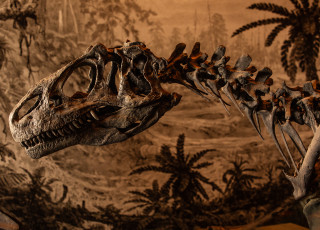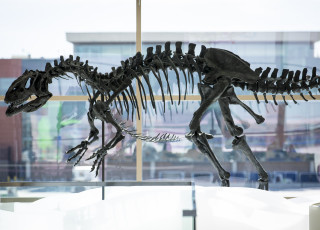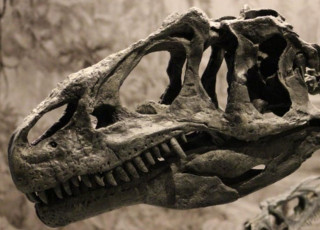The Big Secrets Hidden in Dinosaur Brains
By Olivia Barney
We might as well face it. As a society, we’re a little bit (read: extremely) obsessed with dinosaurs. We build museums as monuments to their towering forms. We produce films that imagine what life might be like if humans and dinosaurs had the chance to interact. Little kids dream of becoming paleontologists when they grow up. Authors and artists use these prehistoric icons as inspiration for stories and artwork that will (in turn) excite and inspire future generations.

Tim Lee, left, Director of Exhibits, NHMU, educates visitors about "Ally at the Airport”, an Allosaurus fragilis, as part of an event celebrating the Phase 3 project, Concourse B on Tuesday, Oct. 22 at the Salt Lake City International Airport. Paleontologists have found more Allosaurus fossils in Utah than anywhere else on earth making it the official state fossil. The 30-foot long cast is based on a near-complete fossil that was collected in 1924 at Dinosaur National Monument near Jensen, Utah. Photo by Jack Rodgers / NHMU
It's a fascination that never gets old. Because just when we think dinosaurs can’t possibly get more impressive or interesting, they do. New species are constantly uncovered. Fossils from the past 30 years indicate many meat-eating dinosaurs were feathered like birds, and further study suggest that even some of these reptilian giants were fluffy. Evidence of pigmentation from these fossil feathers allows us to hypothesize on the variety of colors and patterns that some dinosaur species may have displayed.
Every day, we’re learning more about these ancient animals — an exciting notion which encourages us (scientists and enthusiasts alike) to continue asking new questions and exploring new avenues of thinking.
One recent line of investigation involves looking into dinosaur brains and behavior. What do dinosaur brains look like? Were dinosaurs smart? What can dinosaur brains tell us about their habits and behavior?
Behavior is ultimately the product of the brain, the most mysterious organ of them all.
The obvious challenge to answering these questions is that the brain is a soft-tissue organ. It doesn’t fossilize and preserve the way bones do. So, the very part of the body that could tell us the most about these animals is the part that has been lost to history through the natural processes of decomposition.
But what if the fossilization process could occasionally provide us with a replica of a dinosaur’s brain? When this happens, we get something called an endocast — a treasure trove of dinosaur secrets.
What is an Endocast?
In simplest terms, an endocast is a special rock — sediment filled in the space of an animal’s brain cavity after death (and after the squishy brain decayed) and took on its shape. These endocasts can be extremely accurate — showing you details like ventricles and nerves — because the bones of the skull tightly surround the brain itself, but not all endocasts are created equal. Fossilization requires specific circumstances. That’s why we don’t find perfectly articulated dinosaur skeletons in just any old place we choose to dig. To form an accurate endocast, another important factor must be met: the brain cavity can’t be damaged (which can happen if scavengers are trying to get to the soft tissue inside).
But if you find a dinosaur skull, and if the brain cavity is relatively undamaged, there might be an endocast inside! Here at the Natural History Museum of Utah, we have an exceptionally well preserved Allosaurus fragilis endocast that has been used by researchers in a variety of explorations, including the relationship between non-avian dinosaur, bird, and crocodilian evolution.
NHMU's Allosaurus Endocast
During the 1960s, renowned paleontologist James Madsen helped the University of Utah in a massive excavation at what is now called the Cleveland-Lloyd Dinosaur Quarry — an infamous dinosaur graveyard holding thousands of bones from at least 74 animals, 46 of which were identified as Allosaurus fragilis.

James H. Madsen Jr. maps Allosaurus bones at the Cleveland-Lloyd Dinosaur Quarry. Lisa Madsen
These Allosaurus fossils represented both adult and juvenile specimens, and the excavation is a large part of why NHMU houses so many fossils of this species (and why it’s our state fossil)!
This mass excavation allowed Madsen to conduct some pioneering research on fossil endocasts, but it’s important to note that he wasn’t the first scientist thinking about dinosaur brains. Tilly Edinger, who is widely considered the founding mother of paleoneurology, spent her career researching and theorizing about the topic.
But before the emergence of non-destructive CT imaging technology, studying dinosaur brains came with one major problem: to examine the endocast, you had to sacrifice the skull. You can’t remove the endocast without first breaking the surrounding bone. But with so many new, well-preserved Allosaurus skulls suddenly available for study, Madsen made a calculated decision, choosing to carefully recover the endocast from one of these Allosaurus skulls.
What’s in a Dinosaur Brain?
The brain endocast, which is believed to be from a juvenile Allosaurus, measures approximately 16 cm tall and 16 cm long, but it’s narrow, more closely resembling a crocodilian brain than a human’s (or even a bird’s).
Comparisons of the endocast to modern crocodylian and bird brains have been done to get a sense of how the Allosaurus would have lived and interacted with its environment. We know that Allosaurus fragilis was the apex predator of western North America some 150 million years ago, but now we know a little more about how it moved and hunted.

Close-up of the rear portion of the Allosaurus endocast showing where the spinal cord attaches (on the left), the triangular semicircular canals (center). (NHMU | Bureau of Land Management / UMNH VP 7435) Jack Rodgers / NHMU
Balance: This small triangle shaped area pictured here showcases part of the vestibular system, also known as the semicircular canals, a system which helps maintain balance and posture. Based on its orientation, we know that the Allosaurus likely held its head nearly parallel to the ground while walking.
Sound: The vestibular system also contributes to our ability to hear. And since this system is so similar to crocodylians, it’s likely that the Allosaurus heard low frequencies best and may have struggled to hear higher pitched sounds.
Smell: One particularly interesting observation is in the olfactory bulbs. Allosaurus showcases enlarged olfactory bulbs, suggesting that it depended heavily upon its sense of smell, a skill that likely would have made hunting prey easier — but most modern crocodylians aren’t picky eaters. They may use their sense of smell to identify food, but they don’t discriminate based on taste (despite the senses of taste and smell being related). Allosaurus may have been more selective in what they ate, similar to modern birds. Or perhaps smell was just more important for Allosaurus, whether it be for finding food or picking up the scent of another Allosaurus.
More to Learn — Always
Since Madsen first studied this specimen, many more dinosaur endocasts have been studied using CT scans, so we can now get a better sense of how dinosaur brains varied, and how they evolved in the theropod (meat-eating) lineage on the way to the origin of birds.
We don’t yet have all the answers. Paleontology, like all the sciences, is a continually evolving and growing field. Our knowledge changes with the help of new technology, such as CT imaging, curious minds, and unexpected discoveries. As we keep our minds open to new possibilities and explore the world around us with respect and curiosity, science (like our fascination with dinosaurs) will never get old.




